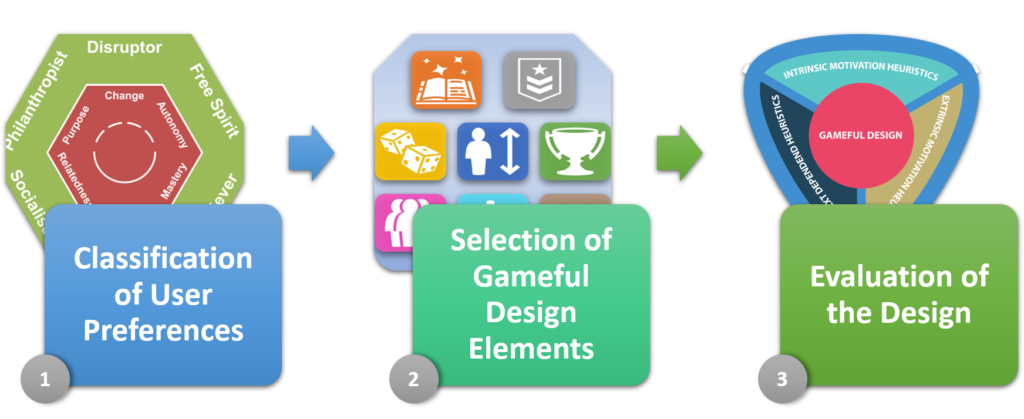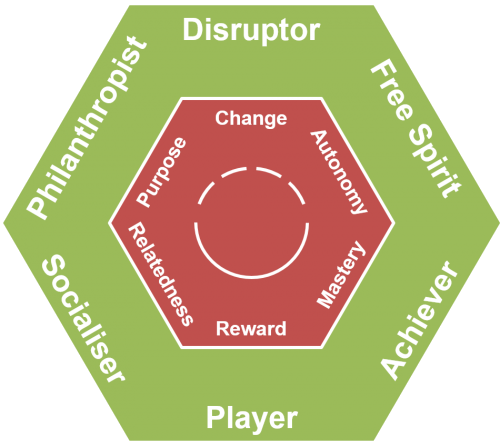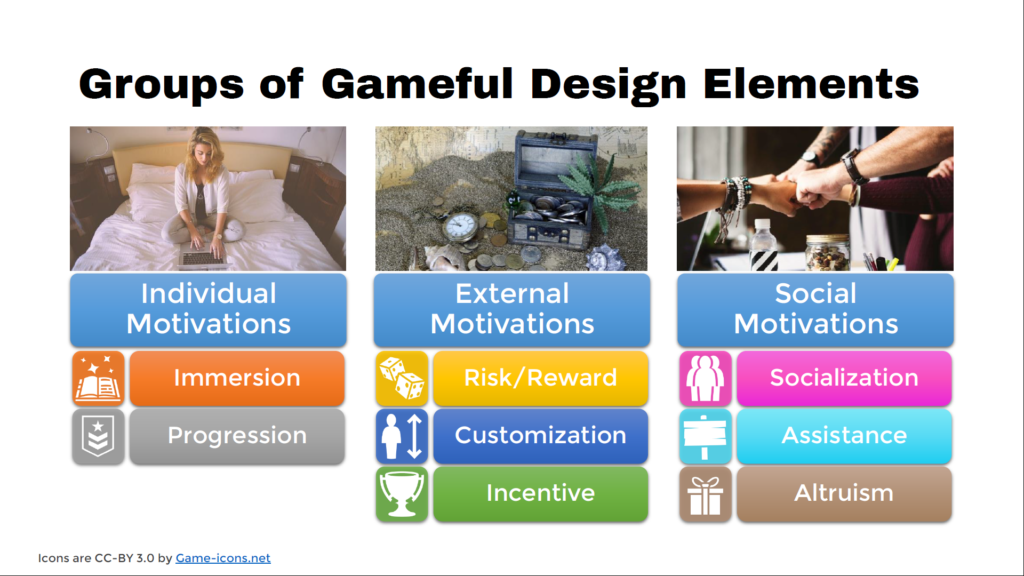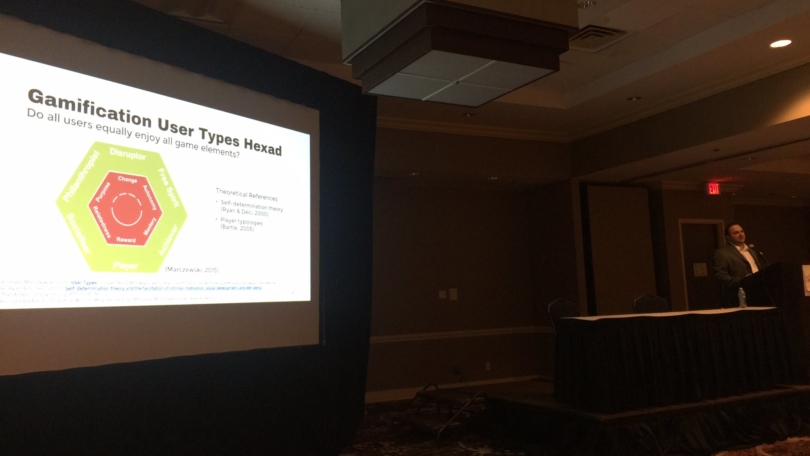In Part 1, I discussed what is personalized gameful design. If you have not read it yet, please take a moment to do it before you continue reading this part.
The method to design personalized gameful applications that I proposed as part of my thesis has three sequential steps: (1) modelling user preferences, (2) selecting the gameful design elements that are more likely enjoyable for each user, and (3) evaluating the motivational potential of the design.

However, please note that these are not all the steps for a complete gameful design method, they are just the steps related to personalization. They are supposed to be integrated into a complete method. I decided to focus only on the steps related to personalization because that was the focus of my Ph.D. research and there are already several great gameful design methods in the literature. I may someday republish these three design steps integrated into my own complete design method, but for now, they can be easily integrated into the gameful design method you already use. If you do not have a gameful design method yet, some popular choices are Marczewski’s Gamification Framework, the Octalysis Framework, Werbach and Hunter’s method, Sententia Gamification’s method, and Kim’s Game Thinking method.
If you prefer a method from academic research, Morschheuser et al.
1suggested a seven-step method based on a study and synthesis of several existing ones: (1) project preparation, (2) analysis of contexts and users, (3) ideation, (4) design of prototypes, (5) implementation, (6) evaluation, and (7) monitoring. To integrate personalized design into these steps, modelling of user preferences would happen in the analysis of users, selection of the gameful design elements would happen in ideation and design of prototypes, and evaluation of the motivational potential could be done earlier during ideation and design to already catch design issues, or later during the evaluation phase.
Next, let’s explain each one of these three steps. Note that I usually mention digital applications because my work is focused on Human-Computer Interaction. However, I do not see any reason why they should not work in non-digital designs as well, but I have not studied the personalization of non-digital gameful systems.
Step 1: Modeling User Preferences
Most gameful design methods already suggest studying the characteristics of users and considering them during the design. But without personalization, designers usually try and find a set of gameful design elements that can satisfy the “average” user. While this may work, the issue is that it may only result in an also average experience, which could be improved with personalization.
To understand this, imagine you are designing an office chair. You do some research and find out that the average height of humans is 1.7 m (5 ft 7 in) for men and 1.6 m (5 ft 3 in) for women
2. So, you design an office chair that is perfectly comfortable for anyone whose height is 1.65 m (5 ft 5 in). That is great for those who are on or near the average, but there are many people who are much shorter or much taller than that and will probably not find the chair very comfortable. That is the problem with designing for an average and the same happens if you do market research and create an average user profile and design for it. It will be great for those users who are really near the average, but probably not so good for those who are distant from it.
One of the potential solutions for this problem is segmentation, which was broadly used in a variety of applications and is still used in many. For example, that is what is usually done for clothes and shoes. Instead of designing clothes in just one size, the population is divided into several segments, so each size (small, medium, large, extra-large, etc.) will be better for a segment of the population. It is certainly much better than having a single size, but now the product is designed for the average within each segment, so the problem is not completely solved. In digital design, the application of this idea could be segmenting the potential users into a few groups, perhaps creating a different persona representing each group, and then design a different version of the system for each group. This may be practical or not depending on what is the context and what system is being designed, but still does not solve the problem perfectly.
The optimal solution is to allow the experience to be personalized for each individual. The best office chairs do not come in a single size or a set of segmented sizes. Instead, they are fully customizable, so the user can adjust the height of the chair, the armrests, the back support, etc. exactly to their own measurements. This practice has also been employed in the digital world. For example, e-commerce websites nowadays tend to use recommendation algorithms to try and find out exactly what each customer might like, instead of just segmenting customers in large groups. This is what, ultimately, we want to achieve with personalized gamification.
To achieve this, it is not enough to just consider user characteristics during the design, but it is necessary to decide which features of the product can be tailored during the use of the product and what characteristics of the user should be taken into consideration. So, office chair designers at some point had to decide that chair height, armrest position, back support height, and other characteristics of the chair were important points to be adjusted for a personalized experience.
In the research of personalized gamification, we have been trying and identifying which characteristics of users influence their experience, so we can choose what to personalize in the system. Research so far has shown that we can represent individual preferences in gameful systems into user type models. Also, several studies have shown that gender, age, and personality can also influence what people enjoy in gameful systems.

As I mentioned in the first part, we can let users customize their own experience or try to create systems that can automatically find out what the user likes and tailor the system to them. Currently, research has mostly been focusing on letting users customize their experience and then observing what is the relationship between the characteristics of users and their choices. If you are letting users customize their own experience, you transfer this responsibility to them. But if the system is going to automatically tailor the user experience, the system will have to keep data about the user (a profile) that can be used to find out what the user likes. This can be obtained by asking questions about the user’s gamification preferences (such as the Hexad user types questionnaire) or personality, or by observing the user interacting with the system and trying to infer their characteristics
3.
At this moment, I believe we do not have the technology yet to create reliable recommendation algorithms, but there are several studies by different research groups underway to build the knowledge we need to do it in the future.
Summarizing this step, designers can take advantage of the knowledge about users that are normally already obtained during a gameful design project. However, instead of just considering this knowledge to design for an average user, of a few segmented users, it is necessary to think about what elements of the gameful system will need to be customizable for each user and to include mechanisms in the system to allow these adjustments to be made. This takes us to the next step.
Step 2: Selection of Gameful Design Elements
Just like an office chair needs to include in its design mechanisms for users to adjust their experience to their preferences, a personalized gameful application needs to include mechanisms for users to tailor their experience.
Therefore, when designing a personalized system, it is not enough to include a few gameful design elements to satisfy the average user. It is necessary to include different design elements so that a few of these elements can be appealing to each user. Next, the designer needs to include some mechanism that allows users to tailor the selection of gameful design elements to their preferences. When designing a system, we could just include different types of elements to appeal for different users, and then just let users interact with the ones they like and ignore the others. That is already much better than just including a few elements and just pleasing a few users. However, a system with too many elements may be overwhelming or distracting. Therefore, it may also be useful to allow users to enable the elements that they like and disable others.
To include elements in the design that can be appealing to different users, I recommend referring to the classification of gameful design elements that I published as part of my research. It includes a list of 49 gameful design elements classified in eight groups organized in three categories: Individual motivations (immersion and progression), External motivations (risk/reward, customization, and incentive), and Social motivations (socialization, assistance, and altruism). Since I already published a three-part post series about this classification, please refer to it for more details. A simple way to ensure that your system includes elements for all user preferences is by trying to include a few elements for each one of the groups.

Next, the designer needs to decide if the system will offer user-controlled customization or system-controlled personalization. If the decision is to offer customization, then the design of the system needs to include mechanisms that allow users to enable or disable the elements according to their preferences, such as the selection interface that I built for a customizable gameful platform that I am using in my research studies:

On the other hand, if the decision is to offer automatic personalization, then the system will need to include a way to collect the user’s profile data and a recommendation algorithm that will select gameful design elements based on the profile. I have published a short research article
4theorizing how such a mechanism could work. However, our current research studies in personalized gamification are still trying to improve the knowledge we have about what user characteristics determine their selection of elements. We have some initial data in the published studies, but we still need more. So, it would currently be difficult to create an accurate recommender algorithm. Therefore, I recommend working with customization, for now, letting users select their game elements and observing how they make their decisions. In the future, with more research, we should be able to also start building recommendation systems for personalized gamification.
Step 3: Heuristic Evaluation of the Design
Of course, after designing a gameful system, it is necessary to evaluate it. The final evaluation of the user experience needs to be conducted with real participants, so the actual emerging experience can be observed and evaluated. However, we at the HCI Games Group created a method for heuristic evaluation of gameful systems: the Gameful Design Heuristics.
Like other heuristic evaluation methods, our heuristics allow evaluators to quickly check a system, but our method is focused on the motivational potential of the system, rather than usability. Our Gameful Design Heuristics contain 28 guidelines of motivational design organized in 12 categories. These guidelines can be used as a checklist to verify if the designers included all the currently identified good design practices in their prototype. This evaluation can be done early in the project, once the design has been initially defined but even before a functional prototype is implemented. This will allow the team to identify potential motivational issues early and go back to the design table to fix them before investing resources in the implementation of the prototype. This can represent a great budget saver for the project.
Once the initial issues identified with the heuristics have been fixed, then the team can proceed to implement the prototype and conducting tests with real participants to find the remaining issues that could not be identified before.
Conclusion
In summary, I introduced a method with three steps to personalize the design of gameful interactive systems: (1) classification of user preferences, (2) classification and selection of gameful design elements, and (3) heuristic evaluation of the design. My goal is not to replace existing gameful design methods, but to specify a set of steps that can be integrated into existing methods to augment them with personalization.
What do you think about this design method? Do you have any questions or suggestions? Have you tried to design a customizable or personalized gameful system and would like to share the experience? I would love to hear from you in the comments!
Also published on Medium.
Notes
- Benedikt Morschheuser, Karl Werder, Juho Hamari, and Julian Abe. 2017. How to gamify? A method for designing gamification. In Proceedings of the 50th Annual Hawaii International Conference on System Sciences (HICSS).
- Max Roser, Cameron Appel and Hannah Ritchie. Human Height. Our World in Data. First published in 2013, updated in May 2019, accessed in December 2019.
- See also these posts about the relationship of the Hexad user types with game element preferences from the HCI Games Group and from Marczewski.
- Gustavo F. Tondello, Rita Orji, and Lennart E. Nacke. 2017. Recommender Systems for Personalized Gamification. In Adjunct Publication of the 25th Conference on User Modeling, Adaptation and Personalization – UMAP’17, 425–430.




1 Comment